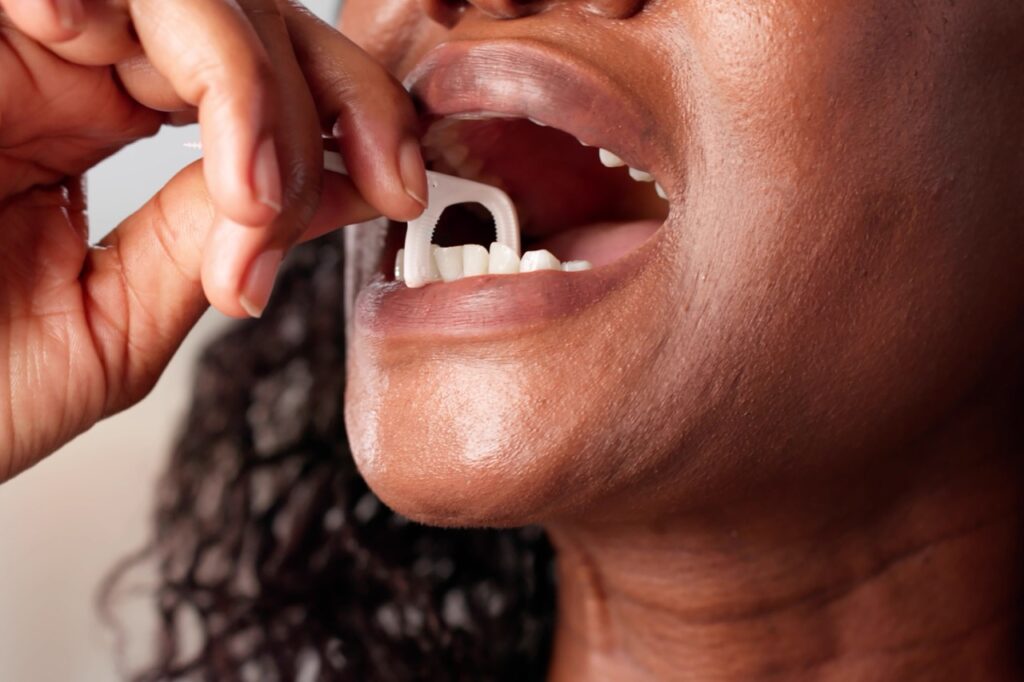Resource Library
Start Reading
If your daily oral care routine is only a two-step process—brush and rinse—you’re not getting your teeth and mouth as clean as you need to.
Why is flossing important, too?
“Quite simply, flossing goes where a toothbrush doesn’t go,” says Dr. Vincent Mayher, Assistant Professor of Clinical Restorative Dentistry at the University of Pennsylvania School of Dental Medicine. “There’s food [and] there’s plaque that’s going to get in between the teeth, and if you’re not flossing, you’re not cleaning all the surfaces of the teeth.”
Dr. Mayher answered some common questions about the importance of flossing. Watch the interview, then read on for more information about one of the simplest but most significant commitments you can make to your oral and overall health.
 To understand how important it is to floss, remember that our mouths harbor hundreds of species of bacteria. Many are harmless. But certain types thrive on leftover food particles, especially sugars, and form a sticky biofilm called plaque.
To understand how important it is to floss, remember that our mouths harbor hundreds of species of bacteria. Many are harmless. But certain types thrive on leftover food particles, especially sugars, and form a sticky biofilm called plaque.
Plaque accumulates in the tight spaces between teeth and along the gum line, where toothbrush bristles don’t reach. Left undisturbed, plaque absorbs minerals from saliva and hardens into a rough, porous deposit called tartar, or dental calculus.
Tartar buildup along the gum line acts as a platform for even more plaque to accumulate. In time, plaque and tartar lead to inflammation, infection, and tooth decay.
Neither brushing nor flossing can remove tartar; a dental hygienist must scrape it away. But you can physically break up plaque before it hardens into tartar by sliding dental floss between the teeth and along the gum line.
Why is flossing important? Because it’s the single most effective way to keep the surfaces between teeth clean and to prevent the cascade of problems that tartar buildup causes.
Neglecting to floss can set the stage for a host of oral health problems, including:
The fallout from failing to floss isn’t necessarily limited to the mouth, either.
“Inflammation for the body as a whole is a bad thing,” says Dr. Mayher. “Chronic inflammation can really wreak havoc on the rest of the body, whether it’s coming from the mouth or not.”
Scientific studies have shown that periodontitis (chronic inflammation and infection of gum tissue) can contribute to the development and worsening of other chronic diseases, including rheumatoid arthritis, Alzheimer’s disease, diabetes, heart disease, and even certain cancers.
 To be sure you’re getting the benefits of flossing, you must floss correctly.
To be sure you’re getting the benefits of flossing, you must floss correctly.
Break off about 18 inches of floss. This length allows you to use a fresh section for each tooth, which helps prevent the transfer of plaque and bacteria.
Wind most of the floss around the middle finger of one hand, and the rest around the middle finger of your other hand. Leave about 1-2 inches of floss to work with.
Holding the floss taut with your thumbs and index fingers, gently slide it between your teeth in a sawing motion. Don’t snap the floss into the gums, which could cause irritation or injury.
Once the floss reaches the gum line, curve it into a C-shape around one tooth. This motion ensures the floss can reach and clean below the gum line.
Gently move the floss up and down against the tooth’s side to remove plaque and debris. Avoid pressing too hard so you don’t damage your gum tissue.
Use a clean section of floss for each tooth. Floss between all teeth, including the often-neglected back teeth.
After flossing, rinse your mouth with water or mouthwash to wash away dislodged bacteria and food debris.
Hydroflossing (water flossing) uses a stream of pulsating water to remove food particles, bacteria, and plaque. The water can also reach deeper into gum pockets and stimulate circulation in the gums, promoting their health.
Water flossing is “kind of a controversial area in dentistry,” says Dr. Mayher. “There are some that say it’s just as good, and others say it’s not as good. Personally, I do both. . . . I have more spaces between my teeth as I get older, so I floss and then I use a water pick.”
Hydroflossing may help some patients, including those with braces, dental implants, crowns, or bridges. However, traditional flossing is more effective at scraping plaque from certain dental surfaces. Talk with your dentist about whether water flossing suits your needs.
The answer to how often you should floss is, “At least once a day.” When in the day you floss is your choice. The most important factor is consistency.
“I try to do it in the morning,” says Dr. Mayher. “If flossing is between me and my bed, I may want to choose my bed! So I get up, I get ready, I get showered, I get dressed, and flossing is part of my morning routine. Find a time [when] it’s not going to be an inconvenience to you, and you’ll probably be a lot more compliant.”
Flossing is effective whether done before or after brushing, according to the American Dental Association.
Some experts recommend flossing first to help dislodge and remove food debris and accumulated plaque. Flossing first can also allow fluoride in the toothpaste that follows to more deeply penetrate tooth enamel, strengthening it even more.
Ultimately, consistent daily flossing matters more than whether you floss or brush first.
 If you find flossing to be a challenge, you’re not alone. But there are tools you can use to make it easier.
If you find flossing to be a challenge, you’re not alone. But there are tools you can use to make it easier.
For example, Dr. Mayher says many of his patients are seniors whose arthritis limits their dexterity. He says a water pick and an ultrasonic toothbrush can help them, as can interdentals. “They look like tiny bottle brushes that go in between your teeth,” he says. “We also have floss aids, floss holders, [and] floss seeds.”
Additionally, some patients who haven’t been flossing regularly find it painful when they start.
“Patients will call and say, ‘Hey, this is killing me! What’s going on? You told me to floss, and now it hurts me.’ It’s really important for a dentist, in advance, to say, ‘When you first start doing this, your gums are going to be sore. But as time goes on, guess what? They toughen up.’ . . . You’ve gotten rid of the chronic inflammation, the gums get healthy, they attach to the teeth, they get pink, and they look better, and flossing ceases to hurt you.”
Now that you know more about why flossing is important, take the next step in keeping your mouth and smile healthy and happy. Visit Penn Dental Family Practice (PDFP) for expert, comprehensive, and compassionate oral health care.
At PDFP, we use the latest knowledge, advanced materials, and patient-focused techniques to keep you in the best possible oral health. Your smile is our priority. Together, we can achieve the best possible outcomes for your dental wellness.
Schedule your appointment online or call us at 215-898-PDFP (7337).